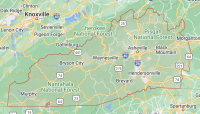Redrawn flood maps render Jackson’s industrial park suddenly worthless
The redrawing of flood maps for North Carolina has made one of Jackson County’s million-dollar properties a tough sell.
The Jackson County Industrial Park, which was formerly the Drexel furniture factory in Whittier, sits along the Tuckasegee River. But starting in 2010, when the new flood maps were drawn largely based on aerial photography, the property was flagged as being in a floodway — the most severe of floodwater classifications.
On previous versions of the state flood maps made in 1974 and 1988, which were drawn by a person on-site as opposed to off-site reliance on aerial photos, the property wasn’t even in the floodplain, according to Tony Elders with the Jackson County Planning Department.
Elders said the new maps, which were made as a joint venture between the Federal Emergency Management Agency and the state’s own emergency management flood mapping agency, neglected to indicate that the property is protected from the river by levies. The error most likely occurred because of the new methodology for surveying the maps.
Now that the county is looking to sell the property, which was assessed at $1.1 million dollars, the buyers are wary of the floodway classification.
County Manager Chuck Wooten said one of the interested parties, the Sequoyah Fund, had been in talks with the county in 2009 and 2010. Then the company re-contacted the county with renewed interest after the new maps were drawn but backed out because of concerns over the new designations.
Related Items
Wooten said as it stands, nothing new can be built, the existing building can’t be modified, and the property may not qualify for federal flood insurance.
However, the county is going to challenge the classification of the property. With an engineering report they could petition for a change, though the cost would have to be covered by the county, Elders said.
The year the maps were made, Jackson County commissioners had the opportunity to contest them before approving them. Haywood County delayed the approval of its maps for about a year while making modifications, Elders said. But now that Jackson’s maps have been approved, in order to make a change the current maps must be disproven.
Jackson County isn’t the only entity affect by the new maps. Elders said he has dealt with hundreds of private landowners who found their properties in a new flood zone after 2010.
“Other areas where we noticed problems are on smaller streams in mountainous areas,” Elders said.
He said Jackson County’s Planning Department has had to work with property owners who were pushed into the new classification, or encountered problems, when the maps were published. When their properties were suddenly flagged as vulnerable to floods under the new maps, the banks that hold a loan for the property have demanded the owner buy flood insurance.
Also, because the new maps are digital, banks can cross reference flood zones with properties for which they hold mortgages. Sometimes, only a corner of the property is in the flood plain, and it doesn’t come near any structures, but the bank will automatically notify the owner they must purchase flood insurance.
Elders said the county has had to step in, or an engineer, to try to convince the bank that the classification was wrong.
“We’ve dealt with numbers in the hundreds whose banks have received the new flood maps and now were required to receive flood insurance when they had never had it before,” Elders said.
Ken Peck, personalized manager with Stanberry Insurance in Sylva, said that flood insurance for one of the lighter classifications of flood zones could cost a residential homeowner upwards of $1,000 per year, while flood insurance for a commercial property could cost much more.









